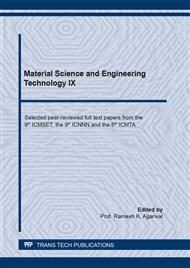[1]
A. A. Ayoola, F. K. Hymore, C. A. Omonhinmin, P. O. Babalola, O. S. I. Fayomi, O. C. Olawole, A.V. Olawepo and A. Babalola: Response Surface Methodology and Artificial Neural Network Analysis of Crude Palm Kernel Oil Biodiesel Production, Chemical Data Collections (2020), p.100478.
DOI: 10.1016/j.cdc.2020.100478
Google Scholar
[2]
M. A. Mujtaba, H. H. Masjuki, M. A. Kalam, H. C. Ong, M. Gul, M. Farooq, M.E.M. Soudagar, W. Ahmed, M.H. Harith and M.N.A.M. Yusoff: Ultrasound-Assisted Process Optimization and Tribological Characteristics of Biodiesel from Palm-Sesame Oil Via Response Surface Methodology and Extreme Learning Machine - Cuckoo Search, Renewable Energy Vol. 158 (2020), pp.202-214.
DOI: 10.1016/j.renene.2020.05.158
Google Scholar
[3]
A. Cukalovic, J.-C. M.Monbaliu, Y. Eeckhout, C. Echim, R. Verhé, G. Heynderickx, and C. V. Stevens: Development, Optimization and Scale-up of Biodiesel Production from Crude Palm oil and Effective Use in Developing Countries, Biomass and Bioenergy Vol. 56 (2013), p.62–69.
DOI: 10.1016/j.biombioe.2013.04.015
Google Scholar
[4]
J. C. Ge, H. Y. Kim, S. K. Yoon, and N. J. Choi: Optimization of Palm Oil Biodiesel Blends and Engine Operating Parameters to Improve Performance and PM Morphology in a Common Rail Direct Injection Diesel Engine, Fuel Vol. 260 (2020), p.116326.
DOI: 10.1016/j.fuel.2019.116326
Google Scholar
[5]
P. S. Moraes, A. V. Igansi, T. R. S. Cadaval, and L. A. A. Pinto: Biodiesel produced from crude, degummed, neutralized and bleached oils of Nile tilapia waste: Production efficiency, physical-chemical quality and economic viability, Renewable Energy Vol. 161 (2020), pp.110-119.
DOI: 10.1016/j.renene.2020.07.092
Google Scholar
[6]
A. B. Fadhil and L. H. Ali: Alkaline-Catalyzed Transesterification of Silurus Triostegus Heckel Fish Oil: Optimization of Transesterification Parameters, Renewable Energy Vol. 60 (2013), p.481–488.
DOI: 10.1016/j.renene.2013.04.018
Google Scholar
[7]
L. K. Dos Santos, R. R. Hatanaka, J. E. de Oliveira and D. L. Flumignan: Production of Biodiesel from Crude Palm Oil by A Sequential Hydrolysis/Esterification Process Using Subcritical Water, Renewable Energy Vol. 130 (2019), p.633–640.
DOI: 10.1016/j.renene.2018.06.102
Google Scholar
[8]
S. Suwanno, T. Rakkan, T. Yunu, N. Paichid, P. Kimtun, P. Prasertsan and K. Sangkharak: The Production of Biodiesel Using Residual Oil from Palm Oil Mill Effluent and Crude Lipase from Oil Palm Fruit as An Alternative Substrate and Catalyst, Fuel Vol. 195 (2017), p.82–87.
DOI: 10.1016/j.fuel.2017.01.049
Google Scholar
[9]
K. Somnuk, P. Smithmaitrie and G. Prateepchaikul: Two-Stage Continuous Process of Methyl Ester from High Free Fatty Acid Mixed Crude Palm Oil Using Static Mixer Coupled with High-Intensity of Ultrasound, Energy Conversion and Management Vol. 75 (2013), p.302–310.
DOI: 10.1016/j.enconman.2013.06.033
Google Scholar
[10]
S.C. Cermak, R.L Evangelista and J.A. Kenar: Distillation of Natural Fatty Acids and Their Chemical Derivatives, National Center for Agricultural Utilization Research, Agricultural Research Service, United States Department of Agriculture, USA, (2012), pp.109-140.
Google Scholar
[11]
Information on https://oilpalmblog.wordpress.com/2016/08/01/physical-refining-deodorisation/.
Google Scholar
[12]
A. Gaurav, S. Dumas, C. T. Q. Mai and F. T. T. Ng: A Kinetic model for a Single Step Biodiesel Production from a High Free Fatty Acid (FFA) Biodiesel Feedstock Over a Solid Heteropolyacid Catalyst, Green Energy & Environment Vol. 4 (2019), pp.328-341.
DOI: 10.1016/j.gee.2019.03.004
Google Scholar
[13]
A. Patel, V. Brahmkhatri and N. Singh: Biodiesel Production by Esterification of Free Fatty Acid Over Sulfated Zirconia, Renewable Energy Vol. 51 (2013), p.227–233.
DOI: 10.1016/j.renene.2012.09.040
Google Scholar
[14]
A. Hayyan, M. Z. Alam, M. E. S. Mirghani, N. A. Kabbashi, N. I. N. M. Y. M. Hakimi, Siran and S. Tahiruddin: Sludge Palm Oil as A Renewable Raw Material for Biodiesel Production by Two-Step Processes. Bioresource Technology Vol. 101 (2010), p.7804–7811.
DOI: 10.1016/j.biortech.2010.05.045
Google Scholar
[15]
A. Bouaid, R. Vázquez, M. Martinez and J. Aracil: Effect of free fatty acids contents on biodiesel quality, Pilot Plant Studies, Fuel Vol. 174 (2016), p.54–62.
DOI: 10.1016/j.fuel.2016.01.018
Google Scholar
[16]
A. Hykkerud and J. M. Marchetti: Esterification of Oleic Acid with Ethanol in The Presence of Amberlyst 15. Biomass and Bioenergy Vol. 95 (2016), p.340–343.
DOI: 10.1016/j.biombioe.2016.07.002
Google Scholar
[17]
S. Chongkhong, C. Tongurai, P. Chetpattananondh and C. Bunyakan: Biodiesel Production by Esterification of Palm Fatty Acid Distillate, Biomass and Bioenergy Vol. 31 (2007), p.563–568.
DOI: 10.1016/j.biombioe.2007.03.001
Google Scholar
[18]
S. Jain and M. P. Sharma: Biodiesel Production from Jatropha Curcas Oil, Renewable and Sustainable Energy Reviews Vol. 14 (2010), p.3140–3147.
DOI: 10.1016/j.rser.2010.07.047
Google Scholar
[19]
S. Natthapon and S. Krit: Optimization of Methyl Ester Production from Palm Fatty Acid Distillate Using Single-Step Esterification: A Response Surface Methodology Approach, ARPN Journal of Engineering and Applied Sciences Vol. 10 (2015), pp.7075-7079.
Google Scholar


